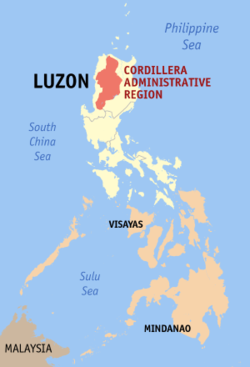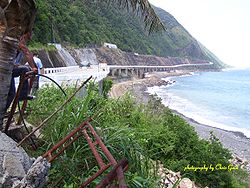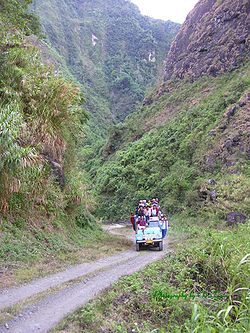
Cordillera Central, Luzon
Encyclopedia





Luzon
Luzon is the largest island in the Philippines. It is located in the northernmost region of the archipelago, and is also the name for one of the three primary island groups in the country centered on the Island of Luzon...
, in the Philippines
Philippines
The Philippines , officially known as the Republic of the Philippines , is a country in Southeast Asia in the western Pacific Ocean. To its north across the Luzon Strait lies Taiwan. West across the South China Sea sits Vietnam...
. Several provinces bound it, namely Benguet
Benguet
Benguet is a landlocked province of the Philippines in the Cordillera Administrative Region in Luzon. Its capital is La Trinidad and borders, clockwise from the south, Pangasinan, La Union, Ilocos Sur, Mountain Province, Ifugao, and Nueva Vizcaya....
, Abra, Kalinga
Kalinga
Kalinga is a landlocked province of the Philippines in the Cordillera Administrative Region in Luzon. Its capital is Tabuk and borders Mountain Province to the south, Abra to the west, Isabela to the east, Cagayan to the northeast, and Apayao to the north...
, Apayao
Apayao
Apayao is a landlocked province of the Philippines in the Cordillera Administrative Region in Luzon. Its administrative capital is Luna and founding capital Kabugao. It borders Cagayan to the north and east, Abra and Ilocos Norte to the west, and Kalinga to the south...
, Mountain Province
Mountain Province
Mountain Province is a landlocked province of the Philippines in the Cordillera Administrative Region in Luzon. Its capital is Bontoc and borders, clockwise from the south, Ifugao, Benguet, Ilocos Sur, Abra, Kalinga, and Isabela.Mountain Province is sometimes incorrectly named Mountain in some...
, Ifugao
Ifugao
Ifugao is a landlocked province of the Philippines in the Cordillera Administrative Region in Luzon. Covering a total land area of 262,820 hectares, the province of Ifugao is located in a mountainous region characterized by rugged terrain, river valleys, and massive forests...
, and Baguio, a chartered city located entirely within Benguet. In the north, it terminates at Pasaleng Bay, Ilocos Norte
Ilocos Norte
Ilocos Norte is a province of the Philippines located in the Ilocos Region in Luzon. Its capital is Laoag City and is located at the northwest corner of Luzon Island, bordering Cagayan and Apayao to the east, and Abra and Ilocos Sur to the south...
, where the coastal bridge Patapat Viaduct winds through. It links with the Sierra Madre
Sierra Madre (Philippines)
The Sierra Madre is a mountain range in The Philippines. It is located along the north-eastern coast of Luzon Island, running north/south. Quezon National Forest Park is situated in the range.-Geography:...
through the Caraballo mountains in Nueva Vizcaya
Nueva Vizcaya
Nueva Vizcaya is a province of the Philippines located in the Cagayan Valley region in Luzon. Its capital is Bayombong. It is bordered by, clockwise from the north, Ifugao, Isabela, Quirino, Aurora, Nueva Ecija, Pangasinan, and Benguet.-History, people and culture:The name was derived from the...
province. During Spanish times, the whole range was called Nueva Provincia, (New Province).
Its inhabitants are a loosely-connected federation of tribes belonging to the mountains. Most tertiary educated Cordillerans speak English
English language
English is a West Germanic language that arose in the Anglo-Saxon kingdoms of England and spread into what was to become south-east Scotland under the influence of the Anglian medieval kingdom of Northumbria...
, since it is the usual medium of instruction at the college level in the Philippines. English is also taught in high school, as well as Filipino (Tagalog). Neither of these languages are commonly spoken at home or at work.
Geography
The Gran Cordillera is the highest and largest mountain range in the Philippines. It comprises about 1/6 of the whole Luzon island with a total area of 18,300 km². The Philippines, as an archipelago of 7,100 islands, is situated between the South-China Sea to the West and the Pacific Ocean (Philippine Sea) in the East. Its main islands are Luzon (on which the capital Manila is situated), Mindanao and Visayas. Total surface is 301,000 km².Population
The population of the Cordillera is about 1.1 million, about 2% of the Philippine population.It is the ancestral domain of the Cordillerans ('people from the mountains'). It is divided into six provinces and seven ethno-linguistic groups: Abra (Tinggian), Apayao (Isneg), Benguet (Kankanaey and Ibaloi), Ifugao (Ifugao), Kalinga (Kalinga, Isneg), Mountain Province (Kankanaey).
An alternative listing for the Northern Philippine tribes is: Apayao/Isnag, Abra/Tinguian, Kalinga, Gaddang, Applai, Mountain Province/Bontoc, Bontok, Bago, I-lagod, Kankana-ey, Kankanai, Balangao, Ibaloi, Ifugao, Ikalahan, Kalanguya, Karao, and Ilongot.
During the American regime, the disparate people of the Cordilleras were not well understood and were all lumped together under the name 'Igorot'. In some circles, especially political ones, this term acquired a pejorative characteristic. In current usage, Northern Cordillerans use it disparagingly, when speaking of people from eastern Mountain Province.
Culture and Language
Each of the seven major ethno-linguistic groups has its own family of languages and cultures. Beside their own tribal cultures, there is a Cordilleran culture which is largely moulded by the geography of the Cordilleras, and their common heritage of resisting the invading imperial powers (Spain, USA, Japan, and Manila), including the continuing adverse encroachments by lowlanders.Notwithstanding their resistance to invasion from the lowlands, the economic language used throughout the Cordilleras is Ilocano, adopted from the lowlander traders of Ilocos.
Cordillerans are a group of indigenous people, recognised as such by Republic law, with their own sets of customary laws. Customary law takes precedence over Republic law. Tribal criminal law takes precedence over the Criminal Code of the Philippines. Murder and manslaughter, for instance is more usually dealt with under tribal law which might include blood debt, only satisfied by the death of the perpetrator. Tribal land law applies in preference to lowland registration law. Spanish deeds were never issued for the land in the Cordilleras since the Spanish were continuously repelled for the whole of Spanish colonial period.
Cordillerans view land as the source of life, an integral part of their cultural identity, that traces its origins from the land. Land is considered sacred and tribal land can neither be owned nor sold, but it nurtured to produce life for the communal benefit. For Cordillerans, the loss of their land, or their alienation from it, can be equivalent to taking their lives. It is because of this belief that Cordillerans now and in the past have willingly shed blood to defend their domain from colonisers, and have fought for the right to remain on their land.
Economy
The Cordillera Autonomous Region is one of the country's richest regions in terms of natural resources. It is a major resource base of the Philippines. It contains 11% of the total area is agricultural rice fields, orchards, pig farms and pasture lands. 60% of the country’s temperate vegetables are produced in the area. It is the country's premier mining district. there are eight big mining companies operating which are mostly foreign controlled. Some 80% of the total Philippine gold production comes from the Cordillera.Another important aspect with respect to potential resources is that the Cordillera is home to the headwaters of the major rivers in Northern Luzon. If these rivers were to be damned it could provide at least five million kilowatts of the total electrical needs (some 56%) of the entire country, but would displace entire populations, drowning their houses and rice terraces, covering existing roads, and ending complete cultures.

Environment
The mountains support a number of different types of habitat. Elevations above 1000m are covered in Luzon tropical pine forestsLuzon tropical pine forests
The Luzon tropical pine forests are a tropical coniferous forest ecoregion of the Philippines in the western Pacific Ocean. These pine forests are home to a large number of the island's endemic plants and animals.-Location and description:...
of Benguet pine (Pinus insularis) except in the north of the range where the high slopes consist of Luzon montane rain forests.
Two major problems threaten the environment of the Cordillera: dam projects flood river valleys and remove habitat and also cause people to flee their houses and seek refuge in other areas; mining project destroy forest areas and also don't create wealth and resources for the upkeep of the tribal lands.
History
The Philippines, named after King Philip II of SpainPhilip II of Spain
Philip II was King of Spain, Portugal, Naples, Sicily, and, while married to Mary I, King of England and Ireland. He was lord of the Seventeen Provinces from 1556 until 1581, holding various titles for the individual territories such as duke or count....
in 1618, was already of interest to Spain before the Spaniards even reached the land. In 1565, reports of huge gold
Gold
Gold is a chemical element with the symbol Au and an atomic number of 79. Gold is a dense, soft, shiny, malleable and ductile metal. Pure gold has a bright yellow color and luster traditionally considered attractive, which it maintains without oxidizing in air or water. Chemically, gold is a...
mines in the Cordillera reached the Viceroy of Mexico, which led to the first official Spanish expedition to the Cordillera in 1576. King Philip III
Philip III of Spain
Philip III , also known as Philip the Pious, was the King of Spain and King of Portugal and the Algarves, where he ruled as Philip II , from 1598 until his death...
, waging the Thirty Year War which needed funding, sent orders for large expeditions to the Philippines.



In 1620, Captain Garcia de Aldana Cabrera offered the resisting Igorot
Igorot
Cordillerans are the people of the Cordillera region, in the Philippines island of Luzon. The word, Igorot is a misnomer term invented by the Spaniards in mockery against the Nortnern Luzon tribes. The word ‘Igorot’ also as coined and applied by the Spaniards means a savage, head-hunting and...
tribal leaders clemency if they were willing to accept Catholic
Catholicism
Catholicism is a broad term for the body of the Catholic faith, its theologies and doctrines, its liturgical, ethical, spiritual, and behavioral characteristics, as well as a religious people as a whole....
religion, obey the Spanish government and pay a fifth of all their mined gold to the Spanish King. They refused and the Spanish conquerors built forts and organized military troops to start the exploitation of the gold mines.
During the years that followed, the Spanish managed to trade gold despite setbacks from the Igorots, who because of their resistance remained relatively independent from Spanish rule. The price that the Igorots had to pay for this independence was that they became different from their colonised brothers.
The Philippines staged Asia’s first nationalistic revolution in 1896, and declared its independence on June 12, 1898.
The newly founded country was soon taken over by the United States of America. The US was the first foreign nation to fully invade the highlands of the Gran Cordillera to push the mining operations in the territory.
Actually, the United States of America was ceded The Philippines at the Treaty of Paris (1898)
Treaty of Paris (1898)
The Treaty of Paris of 1898 was signed on December 10, 1898, at the end of the Spanish-American War, and came into effect on April 11, 1899, when the ratifications were exchanged....
, which officially ended the hostilities of the Spanish-American War
Spanish-American War
The Spanish–American War was a conflict in 1898 between Spain and the United States, effectively the result of American intervention in the ongoing Cuban War of Independence...
. Immediately after this war, the Philippine-American War
Philippine-American War
The Philippine–American War, also known as the Philippine War of Independence or the Philippine Insurrection , was an armed conflict between a group of Filipino revolutionaries and the United States which arose from the struggle of the First Philippine Republic to gain independence following...
pitted the gallant Philippine peoples against yet another foreign occupier, and actual hostilities did not end until 1913. The result of these conflicts led to the USA declaring The Philippines a protectorate
Protectorate
In history, the term protectorate has two different meanings. In its earliest inception, which has been adopted by modern international law, it is an autonomous territory that is protected diplomatically or militarily against third parties by a stronger state or entity...
, which is a reserved status for something less than full statehood, yet more than just an ally. The USA established strategic military bases in The Philippines, with the consent of the established government in Manila. During World War II
World War II
World War II, or the Second World War , was a global conflict lasting from 1939 to 1945, involving most of the world's nations—including all of the great powers—eventually forming two opposing military alliances: the Allies and the Axis...
, the Japanese temporarily overtook the American presence, causing Philippine people to fight alongside by joint the US and Philippine Commonwealth Military in order to extricate the Japanese by 1945.
On September 27, 1927, the Benquet Consolidated Mining Company discovered one of the richest veins of gold ever, at a time when the USA was entering the Great Depression. This was the start of a real gold rush into Cordillera region: in 1929, there were 94 mining companies, by 1933 there were 17,812.
This extreme growth had tremendous results for the landscape; it changed the original one way Mountain Trail into a busy highway despite the road slides and cuts that occur up to this day. Again, similar to the fight against the Spanish, the indigenous inhabitants protested against the destruction of their land and the neglecting of their rights. Mining operations continued to grow and by 1939 the Philippines ranked among the world’s leading gold producers, and second to the state of California among US producers.
From 1936 to 1946 the Philippines was granted domestic self administration under the Commonwealth of the Philippines as a transitional period to complete independence. From 1941 to 1945 the country fell under Japanese rule, and was liberated by military forces of the United States of America, and dare inside by the combined forces of the Allied Philippine Commonwealth military forces and local Igorot and Cordilleran guerrilla forces in Northern Luzon. The USA subsequently recognized Philippine independence on July 4, 1946.
The independent republic’s policy shifted towards the integration of the ‘cultural minorities’ into mainstream culture. In 1966 the Philippine Congress passed the ‘Separation Bill’, dividing the old Mountain Province into four new ones: Benguet, Mountain Province (Bontoc), Ifugao and Kalinga-Apayao. The political elite hoped that the creation of several provinces would, by increasing the region’s representation, increase development spending in the area.
Under the Marcos’ administration, politicization of the Cordillera took a new turn. National government development projects in the area were against the interests of the indigenous peoples, and were strongly resisted by them. Particularly important were the Chico River Dam project and the Cellophil project. The first threatened to inundate traditional villages, the second gave outsiders control over vast forest lands. Resistance resulted in increased regional consciousness rather than local ethnic consciousness.

In 1986, because of financial fraud, Marcos had to step back from office and was succeeded by Corazon Aquino. Under her leadership the human rights situation started to improve; political prisoners were released, repressive laws were repealed and all relevant UN Conventions were ratified.
However, the Aquino administration failed to tackle substantial issues such as land reform and the restructuring of the economy. After the collapse of the negotiations between the government and the National Democratic Front (NDF), Aquino declared the “Total War Policy”, aimed at recovering New People’s Army (NPA) controlled areas and to destroy the NPA’s organizational and infrastructure base. The NPA had moved into the Cordillera to assist in the resistance against the projects.
Current events

The CPA, in co-operation with other organizations, had highly resisted this project and thus booked a little victory. However, in May 2001, president Arroyo declared that the San Roque Dam project would continue anyway because it had already started and therefore was difficult to stop. At the same time she promised to not sacrifice the environment, to resettle the people who will lose their houses, to compensate other people, and to initiate no other large scale irrigation projects in the future. Time will prove whether she will keep that promise.
In December 2000, the Supreme Court of the Philippines dismissed a petition that questioned the constitutional legality of the IPRA. The Indigenous Peoples Rights Act came into existence in 1997 and gave the peoples of the Cordillera decisive influence over the establishment of foreign mining companies. In this act, ownership over the lands was regarded as communal, rather than individual and thus coincided more with the view on ownership of the Igorot. The IPRA was totally different in tone than the 1995 Mining Code.
Without consulting the Cordillera people, this code gave companies the freedom to devastate tribal lands, allowed 100% foreign ownership, and gave companies the right to displace and resettle people within their concessionary areas. Some influential people filed a lawsuit with the Supreme Court against the IPRA, because it contradicted with the Mining Code and would therefore be unlawful. The fact that the Supreme Court had to dismiss the petition, because the vote had been 7-7, could be understood as another victory of the CPA.
In February 2001, president Arroyo spoke with officials from the Cordillera Administrative Region, and promised to start rebuilding the infrastructure and offered the Cordillera people financial assistance for development projects. Some people were surprised when they found out that Arroyo spoke fluently Ilocano (the common language of the Igorot).


